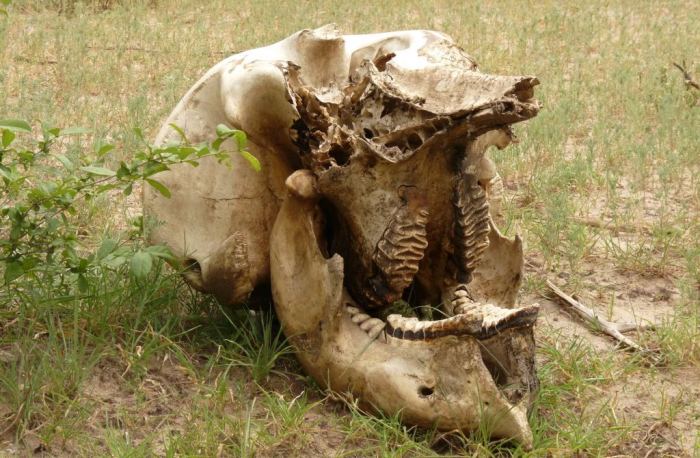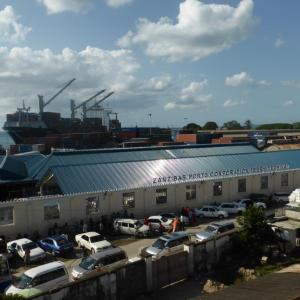Tanzania’s ivory problem more than Chinese diplomatic bags
A major report revealing details of large-scale ivory smuggling from Tanzania to China was released last week by EIA. The report continues to make headlines, with most stories pegged to an allegation by Tanzanian traders that members of the Chinese president’s delegation had purchased illegal ivory in Tanzania.

Elephant skull in the Selous (c) EIA
Let’s be clear here – the main thrust of the report was to document and expose the involvement of organised criminal syndicates, comprised of resident Chinese and local Tanzanians, in the illegal trade in ivory. Through speaking to those involved directly in this illegal trade during a series of field trips to Africa and China in 2014, 2010 and 2006, EIA was able to compile testimonies of Tanzanian ivory traders that they have supplied ivory to Chinese officials. The illegal ivory was then said to be taken out in diplomatic bags – one trader was caught on camera saying he had personally loaded ivory onto a plane carrying Chinese state officials.

Zanzibar Port, Tanzania, September 2014 (c) EIA
The news about the diplomatic bag incident may be eye-catching but it is not new – Chinese media also reported similar testimony in 2012. Fixing solely on this could lead readers and viewers to miss the bigger picture. The report’s key message, drawn from various investigations over the past decade, is that ivory smuggling from Tanzania is being carried out by Chinese-led transnational organised criminal networks and that enforcement needs to be stepped up to tackle this systematic problem.
For the first time, EIA revealed in great detail how these Chinese-led smuggling networks operate across borders from Africa to China. The clandestine business in Tanzania is controlled by Chinese businessmen based in southern China, and mediated by their families and friends in Tanzania, particularly Zanzibar. The trade would be impossible without the collusion of local Tanzanians – in fact, they either front the business as poachers, ivory traders and logistics agents, or back the criminality by abuse of official status.
One member of a criminal network told EIA investigators that even though recent enforcement has dismantled some ivory smuggling networks, a few remain active. He mentioned one boss in particular who succeeded in moving more than 10 containers, each with an estimated two to three tonnes of ivory, to China in 2013. Put in this context, the ivory that reached China via diplomatic bags is most likely a very small fraction compared to the ivory smuggled back systematically by major syndicates.
In 2014, EIA observed ivory was no longer as openly on sale in Tanzania as in previous years. No doubt, the criminal networks that have done so, survive and remain active so by learning from the mistakes of others. Revealing details about their cloak of invisibility and the use of Tanzanians to carry out operations, the network member stressed that a well-executed plan is at the root of successful operations. Those who followed their plans well only saw one of every 20 containers seized. Even when seizures happen, the bosses usually remain at large, he added, referring to the November 2013 seizure in the Tanzanian capital when three Chinese persons were arrested.
EIA has collated information from a number of investigations, reports on seizures and other sources, such as shipping routes, smuggling methods and trading hotspots. The report, Vanishing Point, compiles all this information to illustrate the underlying cause Tanzania’s vanishing elephant herds. The country has lost two-thirds of its elephants in recent years due to poaching and the illegal ivory trade.
EIA has also withheld additional information and prepared confidential briefings which have been provided to enforcement authorities in China and Tanzania. EIA urges both countries to join hands in tackling the criminal networks and ultimately cease all ivory trade.
Vicky Lee
Trade & Policy Analyst.
.
.
中非象牙走私症结不在“高访团”
11月6日一早,伦敦的环境调查署(EIA)发布了一份重要报告, 揭露了大批象牙如何被不法分子从坦桑尼亚走私到中国的犯罪细节。从事这项非法贸易的坦桑尼亚人称,在坦桑尼亚非法购买象牙的客户中,有中国国家主席代表团 的成员。这一报道因此而持续发酵,成为各大媒体的头条;伦敦办公室的工作人员也不停地接到电话,大多数都在询问关于中国“高访团”非法购买象牙的事宜。
环境调查署于2006年、2010年和2014年多次探访非洲和中国,并与从事非法象牙贸易的个人进行了直接对话。在坦桑尼亚和赞比亚,若干 个当地主要象牙商贩在不同年份告诉环境调查署,他们曾将象牙卖给中国官员,这些人据称使用了外交豁免渠道将象牙带回中国——其中有一人甚至称曾亲自将象牙 送上中国政府的飞机。所有这些与商贩的会面均有影像凭证。

Zanzibar Port, Tanzania, September 2014 (c) EIA
尽管外交豁免渠道涉嫌非法象牙走私的消息很吸引眼球,这并不是什么新鲜事——早在2012年,中国媒体就有过报道。但是,需要澄清的是——这份报告的主旨是揭露从事非法象牙贸易的有组织的犯罪集团,其中包括了居住在坦桑尼亚的中国人和坦桑尼亚当地人。如果媒体过分将关注点集中在高访团身上,无疑会误导读者,让他们一叶障目不见泰山。
这份报告回顾了过去十年的多次调查,得出的最关键的信息是,从坦桑尼亚出境的大规模象牙走私活动,是由以中国人为首的跨国犯罪团伙有组织有计划地进行的,有关执法机关需要加大力度打击这种有组织的犯罪活动。
环境调查署首次披露了以中国犯罪分子为首的走私集团如果进行象牙跨境走私的细节。这一秘密勾当在坦桑尼亚,主要是由受控于中国南部某地的商人,并由他们在坦桑尼亚、尤其是桑吉巴岛的亲友从中斡旋、操盘。当然,这类贸易都离不开与坦桑尼亚当地人的共谋——事实上,他们有的以偷猎者、象牙贸易商、物流代理的身份冲在走私一线;有的作为政府官员,在幕后滥用职权、参与犯罪。
2014年,一个属于上述犯罪集团的成员告诉环境调查署的调查员,尽管最近的打击行动确实铲除了一些象牙走私网络,但还是有几个相当活跃。他 特别提到一个老板曾在2013年成功向中国运送了十多个集装箱,在每个箱子里都装载了多达2至3吨的象牙。与这些大型犯罪组织走私象牙的情况相比较,通过 高访团 到达中国的象牙应该只是冰山一角。
2014年,环境调查署发现,象牙已经不再像前几年那样在坦桑尼亚公开出售。无疑,侥幸逃脱的犯罪网络会吸取同行的教训并作出策略调整。上述 名犯罪成员还爆料了犯罪集团如何利用坦桑尼亚当地人来掩盖其犯罪的行为的种种细节。他强调,严格执行计划是一切成功犯罪的基础,那些严格遵照计划的犯罪行 动成功率极高,平均每走私20个集装箱,被查获的只有1箱。他还补充道,就算事情败露,老板们也往往能够逍遥法外,比如2013年11月在坦桑尼亚首都抓 获了3个中国人(来自其家乡,并属于一个类似的团伙),但老板已经逃回中国。根据他的总结,犯罪成功的秘诀在于“周密的计划”和“耐心”——金钱建立和维 系犯罪网络至关重要,而走私货运需要等待时机不能草率行事。
环境调查署已经核对整理了一批调查记录、抓捕报道以及其他资料。通过这些资料,环境调查署整理了有组织犯罪行为的一些细节,比如发货路线、走私方式和热门交易地点等。这份有关中非象牙走私的报告的绝大部分,就是使用上述信息试图阐释坦桑尼亚象群生存危机的背后原因——在近几年,偷猎和非法象牙交易已经使这个国家失去了三分之二的大象。
环境调查署还保留了一些信息,在此报告发布之前已经以绝密简报的形式提供给中国和坦桑尼亚的相关执法部门。环境调查署敦促两国携手打击犯罪网络,最终肃清所有的象牙交易。
李 维琪
贸易与政策分析员
